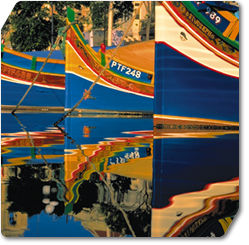- Villa search

- Canaries
- Caribbean
- Croatia, Bulgaria and Hungary
- Cyprus
- Florida
- France and Corsica
- Greece
- Italy
- Lakes and Mountains
- Madeira
- Malta and Gozo
- Portugal
- South Africa
- Spain - Balearics
Information
Country information: CountryName
Map of CountryName

The island transport system is a delight. The buses are often brightly coloured 1950s throwbacks and they provide such a good and frequent service for the locals that tourists can get to most places in period style.
The cars and vans, like the buses, are mostly proudly British and dating from the fifties to seventies, whilst the lorries are for the most part Bedfords and Leylands exported from Britain years ago when well past their first flush of youth. They bear such painted messages as King of Them All, Madonna and Our Lady of Sorrows (on an ancient AEC that hopefully performed better than it looked).
Donkeys and free range cockerels have virtually disappeared from the island and dogs are well looked after, so expect few of the early morning alarm calls that can be a nuisance in other picturesquely rural parts of the Med.
When we visited in early March it was gloriously sunny with temperatures between 10 and 16 degrees centigrade. The sea was just warm enough for snorkelling without a wet suit, but in summer the water reaches a pleasantly-tepid 25 degrees C. Early in the year there were masses of lime-loving spring flowers and a preponderance of green, which we were told disappears by June, after which temperatures continue to soar to around 30 degrees C. Virtually no rain falls after April until the wet month of October (when the climate is similar to southern Britain during a mild June).The tourist season does not usually begin until Easter, meaning that some villas are available cheaply before then. Even at the height of the season, prices remain reasonable. Independently-rented farmhouses with pool, sleeping 6-8, cost from around £595 per week. We checked out the accommodation and found it to be to a high standard with all mod cons, accompanied by attractive rustic furniture and decor, plus of course a good sized pool. Apparently properties without pools are virtually un-lettable, which seems strange with the sea never more than a few miles away.
The farmhouse where we stayed was at Ghasri, half a mile from the coast, down a primitive track, where lizards basked and bees hummed.
All the best accommodation is termed a farmhouse, though this simply indicates a type of angular construction that in the past included central courtyard and barn wing for animals.
Ours was fairly isolated and those from a big town background might find the complete silence at night (apart from the fluttering of bats) and the absence of surrounding houses or street lights a tad daunting.
home | destinations and editorial | villa search | property for sale | car hire | flights | services
villaseek blog | contact villaseek | links and resources | advertise your villa© Dune Root Ltd and Villaseek.com 2012 - Caribbean
- Canaries